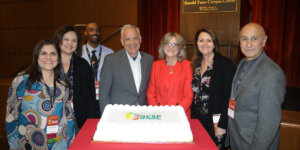
(iStock)
The concepts of memristive devices were first developed in the early 1970s, as scientists tried to improve upon traditional integrated circuits that powered the early computers. Memristive devices, or memristors for short, are resistance-based switches to be used in future computers that allow them to store and process large amounts of information, as demonstrated in traditional memristors previously.
A memristor is built like a super-thin sandwich: The outer slices are metal electrodes, with an insulator in between. Over the decades, the materials used for that middle layer have evolved, and many designs use tantalum oxide or polymers. Today they’re used in a vast array of devices across a variety of applications.
A team of researchers at the USC Viterbi School of Engineering’s Ming Hsieh Department of Electrical and Computer Engineering conducted a comprehensive survey to gain insightful understanding of recent research on a class of materials called van der Waals materials, such as graphene and hexagonal boron nitrade. This review, published Monday in the journal Nature Electronics, suggests that the “unique features of vdW materials provide a greater freedom for creating precisely engineered memristive devices.”
One drawback of using traditional materials is that as scientists try to make them smaller and smaller – below 3 nanometers (three-billionths of a meter) – it’s harder to manufacture them the same each time, across large batches. “A high-quality vdW crystal offers atomic-level local uniformity in both morphology and dimension. Such a uniform switching medium is expected to reduce variations between different devices and switching cycles,” the paper states.
The review was led by Prof. Joshua Yang, Prof. Chongwu Zhou, and Associate Prof. Han Wang. Other USC authors are Mengjiao Li; Hefei Liu; Ruoyu Zhao; Mingrui Chen; and Ye Zhuo. Researchers from the National Chung Hsing University are Feng-Shou Yang and Yen-Fu Lin.
The team also looked at how tiny flaws in memristors actually make them work more efficiently. Past work on the devices has focused on making them perfect, but “imperfections aid function,” Yang said.
Imperfections outside the switching area, like cracks and wrinkles sustained during the fabrication process, have “little impact on the switching behavior,” the paper states. “On the other hand, wrinkles within the switching area potentially offer a platform to investigate the strain effect on memristive dynamics. Furthermore, if we intentionally introduce some missing parts in vdW materials, for example, creating nanopores by ion bombardment or cracking gaps by strain engineering, then we can control the spatial distribution of ion permeability to better manipulate the conductive channel.”
The vdW-enabled memristive devices have application in consumer electronics, as well as vehicles and aerospace technology, Yang said. The USC researchers have been developing such devices and arrays for applications in future computing. They could enable novel hardware accelerators to support machine learning with orders of magnitude higher energy and area efficiency. Also, because such devices share intrinsic similarities with synapses, neurons and dendrites at physics level, they hold promise of enabling bio-realistic artificial intelligence with much advanced intelligence.
About the study: The research (10.1038/s41928-023-00984-2) was supported by the U.S. Department of Defense and the National Science Foundation.
Published on July 17th, 2023
Last updated on March 7th, 2024













